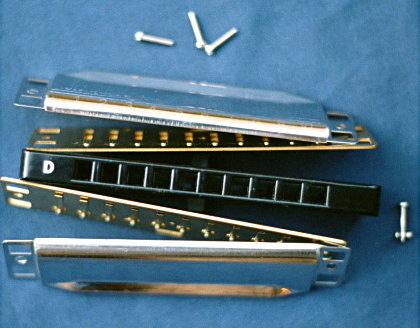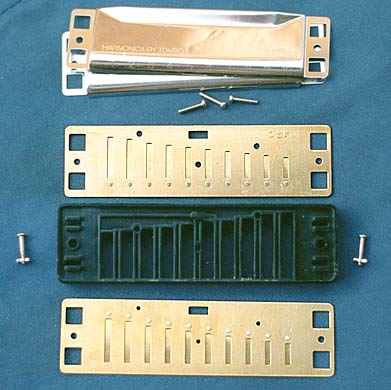General Information
How often should I clean my harmonica?- Maybe never, maybe frequently, this is entirely up to you. Cleaning is not always a good thing. If you are over-zealous in your attempts, you could cause more problems than you solve. Many harmonicas will wear out from use before they ever actually need a cleaning.
When should I clean my harmonica?- If it bothers you, you should clean it. If you think that cleaning could help prevent future problems, then you should clean it. If someone else plays your harmonica, you should probably clean it. If you pickup a used harmonica, you should definitely clean it (for health reasons, we don't recommend buying or playing used harmonicas). If it has been sitting somewhere for months or years, you may want to clean it.
Is it possible to completely sterilize my harmonica?- The answer comes from one of our friends in the medical industry:"It is true that Hydrogen Peroxide will not completely sterilize a harmonica. Unfortunately, true sterilization is very difficult. In the medical office, we use an autoclave (combination of high temperature and high pressure), which is very reliable, but expensive and not available to the public. In addition, autoclave conditions can damage many materials -- I have my doubts that a harmonica would survive. Gas sterilization is used as an alternative for medical instruments such as arthroscopes, etc. which contain latex, plastic, or other materials which would not survive in an autoclave. This is also not available to the public. The general public has access to soap and water, rubbing alcohol, and hydrogen peroxide. Of these, alcohol is probably the best disinfectant, but again this depends on the contact time, and not all organisms can be killed with this. Protected areas (i.e. under a reed plate, etc) may harbor organisms and the alcohol may not penetrate there, limiting its effectiveness. Alcohol also needs to be rinsed off very well. Peroxide is effective for certain organisms, but as I recall, its action spectrum is not as broad as alcohol. I do not know the effects of alcohol or peroxide on the long-term viability of the harmonica itself."
Cleaning a chromatic vs. diatonic harmonica- If your harmonica has a button on the side and white plastic valves over the reeds (which you would see when you take off the metal cover plates), it is a chromatic harmonica and you need to be careful not to disturb those white plastic wind saver valves. By the way, NEVER SOAK A CHROMATIC HARMONICA OR RUN WATER THROUGH IT, it ruins it. Although some of the cleaning instruction here will apply to chromatic harmonica, you are better off following the manufacturers directions or picking up addtional cleaning and repair instruction specifically for chromatics. Cleaning Your Harmonica
Cleaning without taking the harmonica apart- If your diatonic harmonica has a plastic comb (versus a wood or metal comb), you can do a quick cleaning by running luke warm water through it and then rapping it firmly (mouthpiece side down) against your leg or palm to knock out the excess water. Repeat 2 or 3 times being careful to knock out all the water. Lightly playing big full mouth chords (4 or 5 notes) throughout the harmonica will also help clear out the excess moisture. For a light cleaning, this may be all you need.
How often should I clean my harmonica?- Maybe never, maybe frequently, this is entirely up to you. Cleaning is not always a good thing. If you are over-zealous in your attempts, you could cause more problems than you solve. Many harmonicas will wear out from use before they ever actually need a cleaning.
When should I clean my harmonica?- If it bothers you, you should clean it. If you think that cleaning could help prevent future problems, then you should clean it. If someone else plays your harmonica, you should probably clean it. If you pickup a used harmonica, you should definitely clean it (for health reasons, we don't recommend buying or playing used harmonicas). If it has been sitting somewhere for months or years, you may want to clean it.
Is it possible to completely sterilize my harmonica?- The answer comes from one of our friends in the medical industry:"It is true that Hydrogen Peroxide will not completely sterilize a harmonica. Unfortunately, true sterilization is very difficult. In the medical office, we use an autoclave (combination of high temperature and high pressure), which is very reliable, but expensive and not available to the public. In addition, autoclave conditions can damage many materials -- I have my doubts that a harmonica would survive. Gas sterilization is used as an alternative for medical instruments such as arthroscopes, etc. which contain latex, plastic, or other materials which would not survive in an autoclave. This is also not available to the public. The general public has access to soap and water, rubbing alcohol, and hydrogen peroxide. Of these, alcohol is probably the best disinfectant, but again this depends on the contact time, and not all organisms can be killed with this. Protected areas (i.e. under a reed plate, etc) may harbor organisms and the alcohol may not penetrate there, limiting its effectiveness. Alcohol also needs to be rinsed off very well. Peroxide is effective for certain organisms, but as I recall, its action spectrum is not as broad as alcohol. I do not know the effects of alcohol or peroxide on the long-term viability of the harmonica itself."
Cleaning a chromatic vs. diatonic harmonica- If your harmonica has a button on the side and white plastic valves over the reeds (which you would see when you take off the metal cover plates), it is a chromatic harmonica and you need to be careful not to disturb those white plastic wind saver valves. By the way, NEVER SOAK A CHROMATIC HARMONICA OR RUN WATER THROUGH IT, it ruins it. Although some of the cleaning instruction here will apply to chromatic harmonica, you are better off following the manufacturers directions or picking up addtional cleaning and repair instruction specifically for chromatics. Cleaning Your Harmonica
Cleaning without taking the harmonica apart- If your diatonic harmonica has a plastic comb (versus a wood or metal comb), you can do a quick cleaning by running luke warm water through it and then rapping it firmly (mouthpiece side down) against your leg or palm to knock out the excess water. Repeat 2 or 3 times being careful to knock out all the water. Lightly playing big full mouth chords (4 or 5 notes) throughout the harmonica will also help clear out the excess moisture. For a light cleaning, this may be all you need.

For a more thorough cleaning, disassemble cover plates, reed plates, and comb.- Use the appropriate screw driver for your brand of harmonica (flat head or phillips). Fnd a safe place to temporarily store the little screws and nuts that you will get from your disassembly. If they fall to the floor they may disappear forever.
Disassemble cover plates, reed plates, and comb.
Cleaning the comb- You may clean the plastic comb with warm water, soap, and an old tooth brush -- rinse completely. If your comb is made of wood, skip the water and soap and merely rub it down with the old toothbrush. If your comb is metal, be sure to dry it thoroughly upon completion ot avoid rust and tarnish.
Cleaning the cover plates- You may clean the plastic comb with warm water, soap, and an old tooth brush. Rinse well. If your comb is made of wood, skip the water and soap and merely rub it down with the old toothbrush.
Using metal cleaner or brass polish on the cover plates- Not recommended. It is very difficult to completely remove the chemical smell even after a thorough wash and rinse. The tarnishing of the cover plates won't hurt anything including the sound. In fact, some might take it as a sign of an experienced player.
Disassembled cover plates, reed plates, screws, and comb.
Cleaning the reed plates- You may clean the reed plates with warm water and soap and your fingers. Rinse well. You should not wash the reed plates with an old toothbrush. The bristles could get caught on a reed and do damage. Please note that some brands and models of harmonicas have reed rivets that are made of a non-rusting material, others do not. It is possible that without thorough drying, the rivets may begin to rust over time. Therefore, dry as completely as possible before re-assembly.
Cleaning the reed plates while attached to the comb- Very carefully take the harmonica apart down to the comb and attached reed plates. Then take Q-tips and Hydrogen Peroxide Solution (found at any drug store and most supermarkets) and clean the areas that seem to need cleaning. The Hydrogen Peroxide will sanitize, clean, disinfect, and is perfectly safe. Focus special attention on the areas where you will be putting your mouth. Be very careful not to leave any of the extra fuzz from the Q-tips, especially around the reeds (the little thin brass things with a rivet at one end). If you can find some Q-tip type swabs that are not made of cotton but made of some material that doesn't leave lint, that would be even better. This method when carefully applied will also work with chromatic harmonicas. Re-assembling Your Harmonica
Re-attaching the reed plates back on the comb- Use your thumb and forefinger to squeze and slide the plates and comb around until the plates feel "seated" properly within the comb. While securely holding the "seated" reed plates in place, replace the reed plate screws. Do not over-tighten these screws, it doesn't help. Over-tightening tends to cause a warping in the screw areas and increase air leakage. Loose is better than tight. Remember, these plates will also be held securely in place with the final cover plate screws.

Replace the cover plates, not too tight or loose- As with the reed plate screws, do not over-tighten the cover plate screws. Be sure to check that the cover plates are aligned correctly on top of the reed plates before final tightening.
Should one cover plate screw be tighter than the other?- Not necessarily, but you may find that the screw located on the "high end" can cause the harmonica to feel slightly more airtight if it is a bit tighter than the "low end" screw. Sometimes this helps, sometimes not.
总说明
我多频繁应该清洗我的口琴?-可能从未,可能常常地,这完全地是由您决定。 清洁总是不是一件好事。 如果您是过分热忱的在您的尝试,您比您解决可能造成更多问题。 在他们实际上需要清洁之前,许多口琴从用途将用完。
我何时应该清洗我的口琴?-,如果它打扰您,您应该清洗它。 如果您认为清洁可能帮助防止未来问题,则您应该清洗它。 如果别人演奏您的口琴,您应该大概清洗它。 如果您提取一只使用的口琴,您应该明确地清洗它(因健康上的原因,我们不推荐买或演奏使用的口琴)。 如果它几个月或几年来坐某处,您可以想要清洗它。
完全地消毒我的口琴是否是可能的?-答复来自我们的一个医学工业的朋友:“是真实的过氧化氢不会完全地将消毒口琴。 不幸地,真实的绝育是非常困难的。 在医疗办公室,我们使用一台压热器(组合的高温和高压),是非常可靠的,但是昂贵和不可利用对公众。 另外,压热器情况可能损坏许多材料 -- 我有口琴将生存的我的疑义。 气体绝育使用作为选择为医疗仪器例如包含乳汁、塑料,或者其他材料在压热器不会生存的关节镜等等。 这也不供给公众。 公众得以进入用肥皂擦洗的和水、外用酒精和过氧化氢。 这些,酒精大概是最佳的杀菌剂,但是这再取决于联络时间,并且不是所有的有机体可以杀害与此。 被保护区(即在芦苇板材等等之下)也许怀有有机体和酒精可能不击穿那里,限制它的有效率。 酒精也需要很好漂净。 过氧化物为某些有机体是有效的,但是,当我召回,它的行动光谱不是一样宽广的象酒精。 我不了解酒精或过氧化物对口琴的长期生活能力的作用。“
清洗一色彩对全音阶口琴,如果您的口琴有在边的一个按钮和在的白色塑料阀门您会看见的芦苇(您什么时候离开金属盖板),它是一只色彩口琴,并且您需要小心不干扰那些白色塑料风救星阀门。 顺便说一句,不要浸泡一只色彩口琴否则奔跑水通过它,它破坏它。 虽然某些这里清洁指示将适用于色彩口琴,您还好些跟随制造商方向或拾起另外的清洁并且明确地修理指示chromatics的。 清洗您的口琴
清洗,无需拆散口琴,如果您的全音阶口琴有塑料梳子(对木头或金属梳子),您能通过信息业跑卢克温暖的水通过它然后敲击做快的清洁(下来喉舌边)反对您的腿或棕榈击倒过量水。 重复2或3的次小心击倒所有水。 轻演奏大充分的嘴弦(4或5笔记)在口琴中清楚地也将帮助剩余湿气。 对于轻的清洁,这也许是您需要的所有。
对于更加详尽的清洁,拆卸盖板、芦苇板材和梳子。-为口琴您的品牌使用适当的螺丝刀(平的头或菲利普)。 Fnd临时地存放您从您的拆卸将得到的小的螺丝和坚果的一个安全的地方。 如果他们落对地板他们也许永远消失。
拆卸盖板、芦苇板材和梳子。
清洗梳子您可以清洗塑料梳子与温暖的水、肥皂和一把老牙刷 -- 完全冲洗。 如果您的梳子由木头制成,跳水和肥皂和用老牙刷仅仅摩擦它下来。 如果您的梳子是金属,请务必烘干它在完成ot十分地避免铁锈和污名。
清洗盖板您可以清洗塑料梳子与温暖的水、肥皂和一把老牙刷。 冲洗井。 如果您的梳子由木头制成,跳水和肥皂和用老牙刷仅仅摩擦它下来。
使用金属擦净剂或在没建议使用的盖板的黄铜擦亮剂。 在周到洗涤和冲洗以后完全地去除化工气味是非常难的。 使失去光泽盖板不会损害什么包括声音。 实际上,一些也许采取它作为一个老练的球员的标志。
被拆卸的盖板、芦苇板材、螺丝和梳子。
清洗芦苇板材您可以用温暖的水清洗芦苇板材和肥皂和您的手指。 冲洗井。 您不应该洗涤与一把老牙刷的芦苇板材。 刺毛在芦苇能被逮住,并且损坏。 请注意:口琴有些品牌和模型有被做非生锈的材料的芦苇铆钉,其他不。 是可能的,不用周到干燥,铆钉也许开始随着时间的推移生锈。 所以,烘干一样完全地尽可能在重新组装之前。
清洗芦苇板材,当附加梳子非常时小心地中断口琴分开到梳子和附上芦苇板材。 然后采取棉条和过氧化氢解答(被找到在任何药店和多数超级市场)并且清洗似乎需要清洗的区域。 过氧化氢将消毒,清洗,消毒,并且是完全安全的。 集中特别留意于您投入您的嘴的区域。 非常小心不特别是在芦苇(与一个铆钉的少许稀薄的黄铜事附近留下其中任一根从棉条的额外绒毛,在一个末端)。 如果您能找到没有由棉花制成,而是由一些材料制成不离开棉绒的一些棉条类型拖把,那是更好的。 这个方法,当小心地应用也与色彩口琴一起使用。 重新召集您的口琴
再依附芦苇板材在梳子用途您的拇指和食指对squeze和滑板材和梳子,直到板材感觉“适当地安装”在梳子之内。 当安全对负“供以座位”到位时芦苇的板材,替换芦苇板材螺丝。 不要过分拧紧这些螺丝,它不帮助。 过分拧紧在螺丝区域倾向于导致翘曲和增加气漏。 宽松比紧紧好。 记住,这些板材将安全地也对负到位与最后的盖板螺丝。
不太紧紧替换盖板,或疏松与芦苇板材螺丝,不要过分拧紧盖板螺丝。 请务必检查盖板恰当地被排列在最后拉紧之前的芦苇板材顶部。
一个盖板螺丝比其他应该是紧?-不一定,但是您可以发现位于“高端”的螺丝可能造成口琴感到有一点更加不漏气,如果它比“低价的”螺丝有点儿紧。 有时这帮助,有时没有。
我多频繁应该清洗我的口琴?-可能从未,可能常常地,这完全地是由您决定。 清洁总是不是一件好事。 如果您是过分热忱的在您的尝试,您比您解决可能造成更多问题。 在他们实际上需要清洁之前,许多口琴从用途将用完。
我何时应该清洗我的口琴?-,如果它打扰您,您应该清洗它。 如果您认为清洁可能帮助防止未来问题,则您应该清洗它。 如果别人演奏您的口琴,您应该大概清洗它。 如果您提取一只使用的口琴,您应该明确地清洗它(因健康上的原因,我们不推荐买或演奏使用的口琴)。 如果它几个月或几年来坐某处,您可以想要清洗它。
完全地消毒我的口琴是否是可能的?-答复来自我们的一个医学工业的朋友:“是真实的过氧化氢不会完全地将消毒口琴。 不幸地,真实的绝育是非常困难的。 在医疗办公室,我们使用一台压热器(组合的高温和高压),是非常可靠的,但是昂贵和不可利用对公众。 另外,压热器情况可能损坏许多材料 -- 我有口琴将生存的我的疑义。 气体绝育使用作为选择为医疗仪器例如包含乳汁、塑料,或者其他材料在压热器不会生存的关节镜等等。 这也不供给公众。 公众得以进入用肥皂擦洗的和水、外用酒精和过氧化氢。 这些,酒精大概是最佳的杀菌剂,但是这再取决于联络时间,并且不是所有的有机体可以杀害与此。 被保护区(即在芦苇板材等等之下)也许怀有有机体和酒精可能不击穿那里,限制它的有效率。 酒精也需要很好漂净。 过氧化物为某些有机体是有效的,但是,当我召回,它的行动光谱不是一样宽广的象酒精。 我不了解酒精或过氧化物对口琴的长期生活能力的作用。“
清洗一色彩对全音阶口琴,如果您的口琴有在边的一个按钮和在的白色塑料阀门您会看见的芦苇(您什么时候离开金属盖板),它是一只色彩口琴,并且您需要小心不干扰那些白色塑料风救星阀门。 顺便说一句,不要浸泡一只色彩口琴否则奔跑水通过它,它破坏它。 虽然某些这里清洁指示将适用于色彩口琴,您还好些跟随制造商方向或拾起另外的清洁并且明确地修理指示chromatics的。 清洗您的口琴
清洗,无需拆散口琴,如果您的全音阶口琴有塑料梳子(对木头或金属梳子),您能通过信息业跑卢克温暖的水通过它然后敲击做快的清洁(下来喉舌边)反对您的腿或棕榈击倒过量水。 重复2或3的次小心击倒所有水。 轻演奏大充分的嘴弦(4或5笔记)在口琴中清楚地也将帮助剩余湿气。 对于轻的清洁,这也许是您需要的所有。
对于更加详尽的清洁,拆卸盖板、芦苇板材和梳子。-为口琴您的品牌使用适当的螺丝刀(平的头或菲利普)。 Fnd临时地存放您从您的拆卸将得到的小的螺丝和坚果的一个安全的地方。 如果他们落对地板他们也许永远消失。
拆卸盖板、芦苇板材和梳子。
清洗梳子您可以清洗塑料梳子与温暖的水、肥皂和一把老牙刷 -- 完全冲洗。 如果您的梳子由木头制成,跳水和肥皂和用老牙刷仅仅摩擦它下来。 如果您的梳子是金属,请务必烘干它在完成ot十分地避免铁锈和污名。
清洗盖板您可以清洗塑料梳子与温暖的水、肥皂和一把老牙刷。 冲洗井。 如果您的梳子由木头制成,跳水和肥皂和用老牙刷仅仅摩擦它下来。
使用金属擦净剂或在没建议使用的盖板的黄铜擦亮剂。 在周到洗涤和冲洗以后完全地去除化工气味是非常难的。 使失去光泽盖板不会损害什么包括声音。 实际上,一些也许采取它作为一个老练的球员的标志。
被拆卸的盖板、芦苇板材、螺丝和梳子。
清洗芦苇板材您可以用温暖的水清洗芦苇板材和肥皂和您的手指。 冲洗井。 您不应该洗涤与一把老牙刷的芦苇板材。 刺毛在芦苇能被逮住,并且损坏。 请注意:口琴有些品牌和模型有被做非生锈的材料的芦苇铆钉,其他不。 是可能的,不用周到干燥,铆钉也许开始随着时间的推移生锈。 所以,烘干一样完全地尽可能在重新组装之前。
清洗芦苇板材,当附加梳子非常时小心地中断口琴分开到梳子和附上芦苇板材。 然后采取棉条和过氧化氢解答(被找到在任何药店和多数超级市场)并且清洗似乎需要清洗的区域。 过氧化氢将消毒,清洗,消毒,并且是完全安全的。 集中特别留意于您投入您的嘴的区域。 非常小心不特别是在芦苇(与一个铆钉的少许稀薄的黄铜事附近留下其中任一根从棉条的额外绒毛,在一个末端)。 如果您能找到没有由棉花制成,而是由一些材料制成不离开棉绒的一些棉条类型拖把,那是更好的。 这个方法,当小心地应用也与色彩口琴一起使用。 重新召集您的口琴
再依附芦苇板材在梳子用途您的拇指和食指对squeze和滑板材和梳子,直到板材感觉“适当地安装”在梳子之内。 当安全对负“供以座位”到位时芦苇的板材,替换芦苇板材螺丝。 不要过分拧紧这些螺丝,它不帮助。 过分拧紧在螺丝区域倾向于导致翘曲和增加气漏。 宽松比紧紧好。 记住,这些板材将安全地也对负到位与最后的盖板螺丝。
不太紧紧替换盖板,或疏松与芦苇板材螺丝,不要过分拧紧盖板螺丝。 请务必检查盖板恰当地被排列在最后拉紧之前的芦苇板材顶部。
一个盖板螺丝比其他应该是紧?-不一定,但是您可以发现位于“高端”的螺丝可能造成口琴感到有一点更加不漏气,如果它比“低价的”螺丝有点儿紧。 有时这帮助,有时没有。




No comments:
Post a Comment